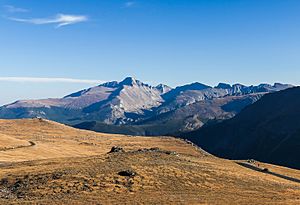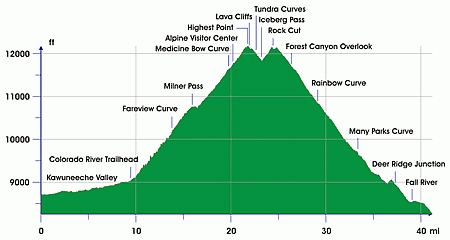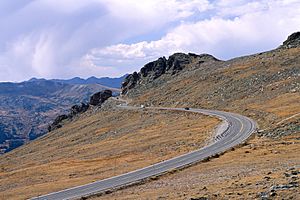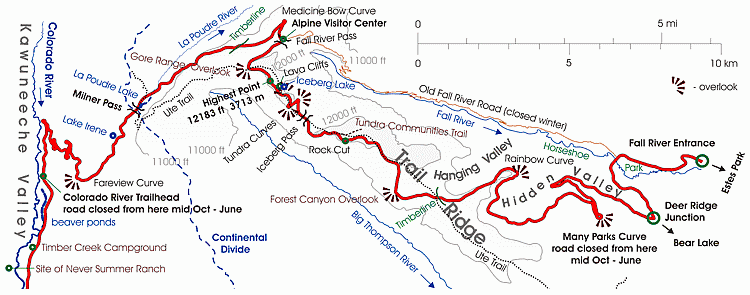Trail Ridge Road facts for kids
Quick facts for kids
U.S. Route 34 |
|
|---|---|
| Trail Ridge Road | |

Schematic map of the Trail Ridge Road
|
|
| Route information | |
| Maintained by NPS | |
| Length | 48 mi (77 km) |
| Existed | 1932–present |
| Tourist routes |
|
| Major junctions | |
| West end | Grand Lake |
| East end | Estes Park |
| Location | |
| Counties: | Grand County, Larimer County |
| Highway system | |
| United States Numbered Highways List • Bannered • Divided • Replaced Colorado State Highways |
|
|
Trail Ridge Road
|
|
| NRHP reference No. | 84000242 |
| Added to NRHP | November 14, 1984 |
Trail Ridge Road is the name for a stretch of U.S. Highway 34 that traverses Rocky Mountain National Park from Estes Park, Colorado in the east to Grand Lake, Colorado in the west. The road is also known as Trail Ridge Road/Beaver Meadow National Scenic Byway.
Trail Ridge Road is closed during the winter, and often remains closed until late spring or early summer depending on the snowpack. The Trail Ridge Road is the highest paved through road in Colorado and it is also the highest paved road in Colorado that crosses the continental divide (Cottonwood Pass at 12,126 feet is the second highest, and Colorado State Highway 82 at 12,095 feet going through Independence Pass is the third highest).
Route description

From Kawuneeche Visitor Center at the park's Grand Lake Entrance, Trail Ridge Road follows the North Fork of the Colorado River north through the Kawuneeche Valley. There are several trailheads along this section of the road, notably the Colorado River Trailhead, which is the western terminus of the road segment closed during the winter.
The road crosses the Continental Divide at Milner Pass (elev. 10,758 ft or 3,279 m) and reaches a maximum elevation of 12,183 ft (3,713 m), near Fall River Pass (elev. 11,796 ft or 3,595 m). Near the highest point on the road is another pass, Iceberg Pass (elev. 11,827 ft or 3,605 m).
According to construction contracts and park maintenance files the east end of the road is located at the Fall River Entrance, however some guides state that earlier - at Deer Ridge Junction.
Trail Ridge is a high flat spur range extending east from the main range of the Rockies between Fall River in the North and the Big Thompson River in the South. The road follows Trail Ridge from the Fall River Pass near Alpine Visitor Center to the Deer Ridge Junction.

History
Trail Ridge had been used by Native Americans to cross the mountains between their home lands in the west and hunting areas on the east side. Arapahoe Indians called the trail located on the ridge as "taienbaa" ("Where the Children Walked") because it was so steep that children could not be carried, but had to walk. The Ute tribe crossing the mountains at Forest Canyon Pass marked their route with stone cairns. The present park Ute Trail follows partially that ancient route.
On the west side, about 1880, a wagon road was constructed along the Kawuneeche Valley from the town of Grand Lake to the mining camps of Lulu City and Gaskill. The camps were abandoned after a few years when short-lived mining boom ended and later the road was used only occasionally by hunters and tourists.
Fall River Road was the first road into the park's high country. It opened in 1921 and quickly proved inadequate for motor travel as a single-track road with steep grades (up to 16%), tight curves and a short annual season due to snowpack. Construction began in 1929 and was complete to Fall River Pass by July 1932, with a maximum grade of 7%. The road was complete through the Kawuneeche Valley to Grand Lake in 1938. The route followed what was known to local Arapaho Indians as the Dog Trail. Internal opposition to the construction of a road through the park's alpine tundra was overruled by National Park Service director Horace Albright, who wished to encourage park visitation. The road was designed to intrude as little as possible into the landscape, in accordance with Park Service design principles.
Hidden Valley (or Ski Estes Park) was a local ski area attraction from 1955 - 1991, off of Trail Ridge Road, now defunct.
See also
 In Spanish: Trail Ridge Road para niños
In Spanish: Trail Ridge Road para niños





